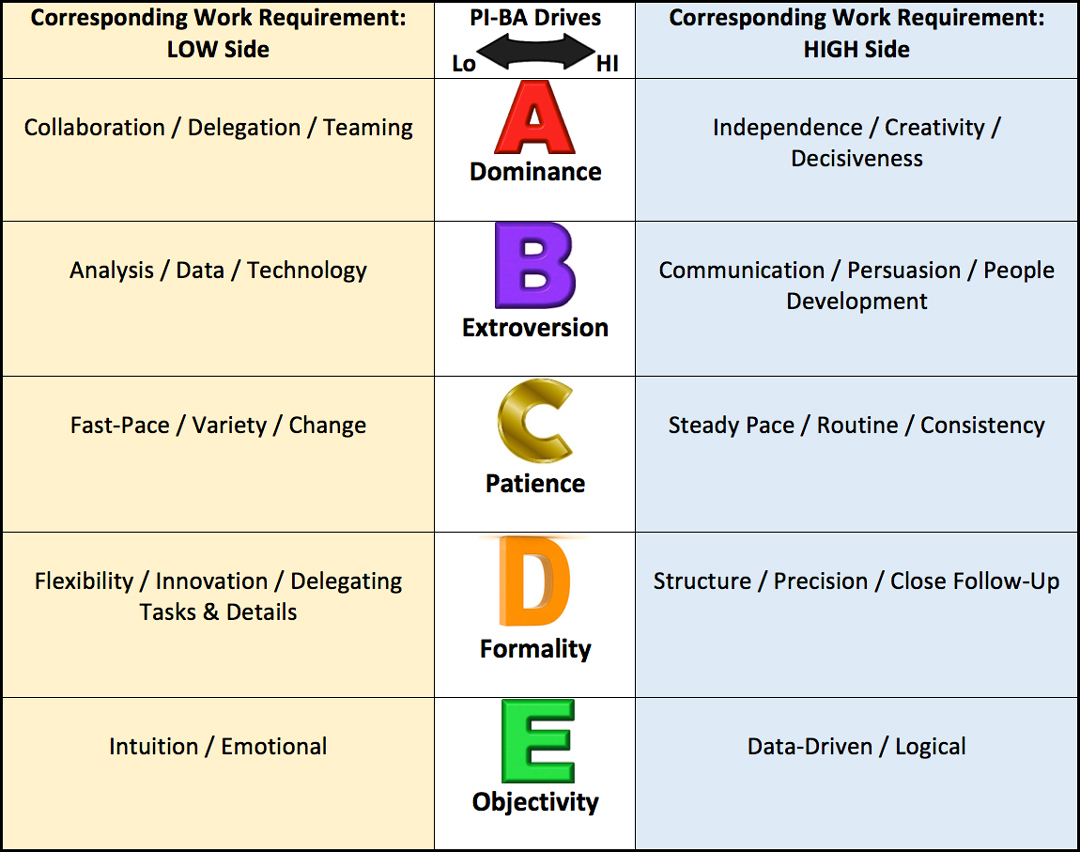Consider the Full Scope of Job Requirements
Managers make many people decisions over the life-cycle of employees’ time with a company: hiring, development, assignments, and promotion. Consideration is given to the education, training, skills, and previous experience that each person brings to the specific situation. Sometimes, structured interviews or evaluations help the values of the individuals surface, so we can see if they match those of the organization.
Often, though, not enough emphasis is placed on the behavioral requirements of the roles under consideration. For example:
- Does the job require a people-orientation with an emphasis on communication, persuasion, influencing, delegating, and development?
- Or does it require more of an analytical focus on tasks and a technical orientation?
- Is the work structured with clear instructions, rules, and regulations to follow?
- Or is the work environment more ambiguous with a strong need for independence, creativity, flexibility, and innovation?
The Predictive Index Assessments in Action:
As a real-life example, I worked with a fast-food franchisee who was trying to grow rapidly from 200 restaurants to over 500 in a few years. However, they were experiencing 300% turnover among their Restaurant Managers and were unable to grow.
When asked what type of person they were targeting in their recruiting, they said “independent, entrepreneurial types – like us!”. The unintended result was people coming into the role for a couple of years, learning the business, then leaving to start their own restaurants.
Using the Predictive Index® Behavior Assessment (BA), we measured the innate drives of the existing managers, who were ranked by performance criteria and tenure. The results showed that the top quartile of performers who also stayed the longest had two significant traits in common – they were more structured, by-the-book types who also had a stronger sense of urgency.
While the owners were surprised by the outcome of the study, the company decided to continue using the BA and shifted their strategy to recruiting retiring non-commissioned officers from the military. These were mature people who had been excelling in a disciplined environment and were looking for the next good and structured opportunity. By correctly screening candidates, they fit the role well, turnover fell, and the company was able to get back on its planned growth track.
The lesson learned was to evaluate the work first, then the people. The examination of the work influenced not only the recruiting and hiring process but also the training and development programs as well as the company succession plan.
Using the ABCD’s (and E’s!) of the Work
Here are the key dimensions of Work Behavior, using the terminology of the Predictive Index® Behavior Assessment. The BA Drives are shown in the middle column, while the corresponding work behaviors are shown to the left (LOW) and right (HIGH) – i.e. Collaboration corresponds to lower levels of Dominance while Independence corresponds to higher levels of Dominance:

You can plot the key work requirements along each dimension above, either on the High or Low side. This will provide a practical guideline for screening candidates as well as a guide for communicating the expectations of the role more clearly to incumbents.
The Predictive Index Job Assessment provides a more detailed process for analyzing the key elements of work behavior. The results range from facilitated consensus job profiles to statistical validity studies.
Using Data to Improve Decisions and Planning
Clients also use this method as a frame work for Training and Development plans, Promotions, and Succession Planning. Of course, the key to using such a framework is also having an assessment tool like the BA that measures a person’s drives so that you can make meaningful comparisons to the role requirements.
This does not mean that you simply screen out people who do not match the profile. They may have potential for other roles in the organization beyond the current role.
The fast-food company mentioned above still found a few “independent, entrepreneurial types” that they wanted to bring in to the company because they saw potential above the Restaurant Manager role. However, it was made clear that success at the Restaurant Manager level required consistently executing the approved processes and procedures well.
To learn more or to arrange for a complimentary trial of the PI Job and Behavior Assessments, please complete the contact information to the right of this post or email us at [email protected].






